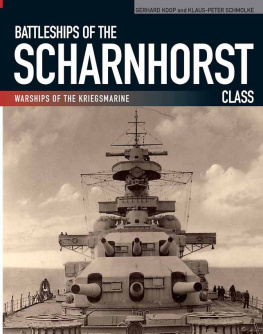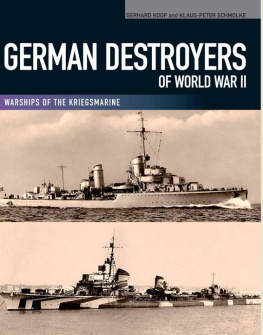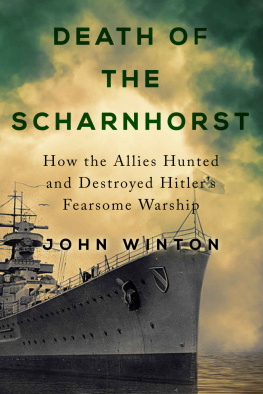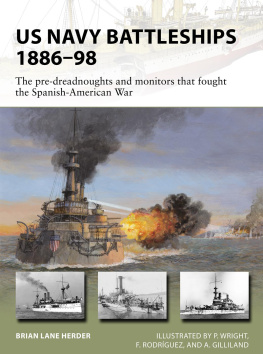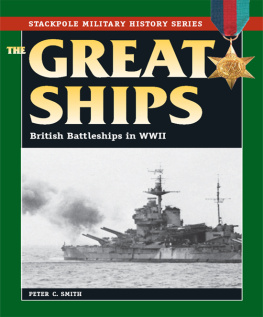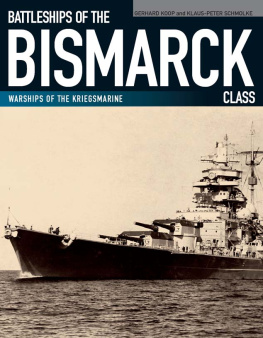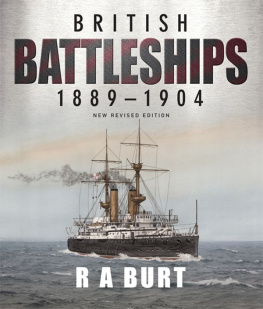Gerhard Koop - Battleships of the Scharnhorst Class
Here you can read online Gerhard Koop - Battleships of the Scharnhorst Class full text of the book (entire story) in english for free. Download pdf and epub, get meaning, cover and reviews about this ebook. publisher: Seaforth Publishing, genre: Non-fiction. Description of the work, (preface) as well as reviews are available. Best literature library LitArk.com created for fans of good reading and offers a wide selection of genres:
Romance novel
Science fiction
Adventure
Detective
Science
History
Home and family
Prose
Art
Politics
Computer
Non-fiction
Religion
Business
Children
Humor
Choose a favorite category and find really read worthwhile books. Enjoy immersion in the world of imagination, feel the emotions of the characters or learn something new for yourself, make an fascinating discovery.
- Book:Battleships of the Scharnhorst Class
- Author:
- Publisher:Seaforth Publishing
- Genre:
- Rating:4 / 5
- Favourites:Add to favourites
- Your mark:
- 80
- 1
- 2
- 3
- 4
- 5
Battleships of the Scharnhorst Class: summary, description and annotation
We offer to read an annotation, description, summary or preface (depends on what the author of the book "Battleships of the Scharnhorst Class" wrote himself). If you haven't found the necessary information about the book — write in the comments, we will try to find it.
Battleships of the Scharnhorst Class — read online for free the complete book (whole text) full work
Below is the text of the book, divided by pages. System saving the place of the last page read, allows you to conveniently read the book "Battleships of the Scharnhorst Class" online for free, without having to search again every time where you left off. Put a bookmark, and you can go to the page where you finished reading at any time.
Font size:
Interval:
Bookmark:

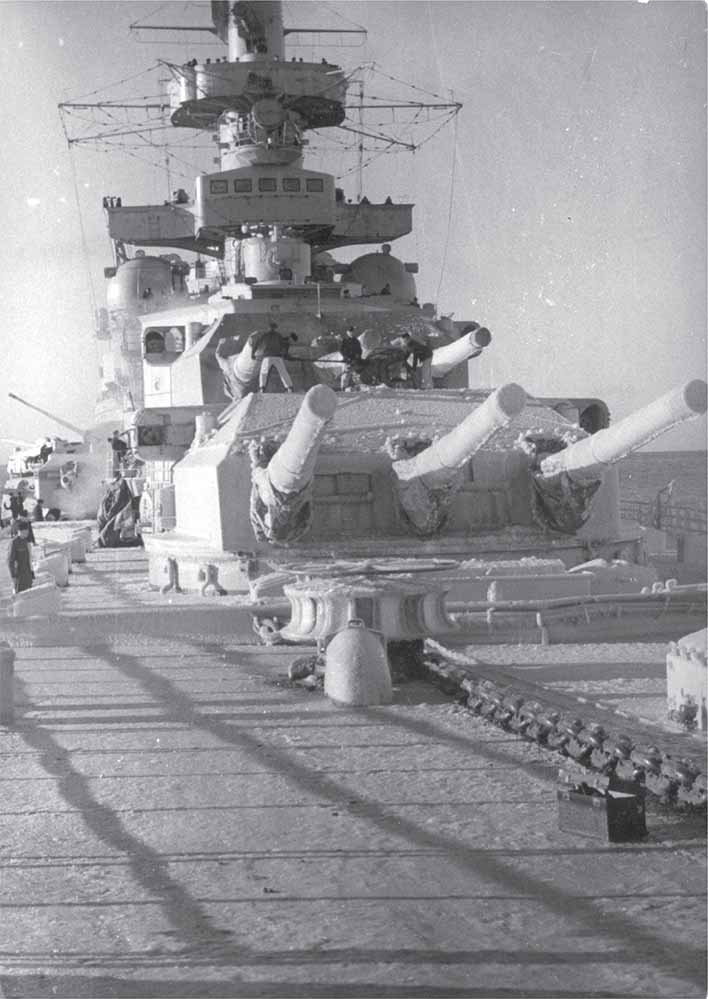
Gneisenau in the winter of 1939/40

The Scharnhorst and Gneisenau:
The Backbone of the German Surface Forces at the Outbreak of War
GERHARD KOOP and KLAUS-PETER SCHMOLKE

Copyright Bernard & Graefe Verlag, Bonn, 1991
This edition first published in Great Britain in 2014 by
Seaforth Publishing,
Pen & Sword Books Ltd,
47 Church Street,
Barnsley S70 2AS
www.seaforthpublishing.com
British Library Cataloguing in Publication Data
A catalogue record for this book is available from the British Library
ISBN 978 1 84832 192 2
First published in the German language under the title Die Schlachtschiffeder Scharnhorst-Klasse
by Bernard & Graefe Verlag, Bonn, 1993
First published in the English language by Greenhill Books, Lionel Leventhal Ltd, 1999
All rights reserved. No part of this publication may be reproduced or transmitted in any form
or by any means, electronic or mechanical, including photocopying, recording, or any
information storage and retrieval system, without prior permission in writing of both the
copyright owner and the above publisher.
Translated from the German by Geoffrey Brooks
Printed and bound in China through Printworks International Ltd
Contents
Battleships of the Scharnhorst Class presents detailed information in the same manner as its companion volume Battleships of the Bismarck Class. The book opens with a short history of the development stage which led to the construction of the two ships of the class. This is followed by an in-depth career history of each vessel, concluding with a critical epilogue. Also provided are detailed tables of design, construction and technical/tactical data regarding weapons and weapons systems, machinery, equipment and crew strength. A comprehensive selection of photographs, accompanied by a full narrative, technical drawings and battle charts, complete the book.
In naming the two ships, the Kriegsmarine followed an old tradition of the Imperial Navy which bestowed upon vessels of certain classes the names of important German historical figures. The battleship Scharnhorst was the second warship to bear the name, Gneisenau the third. The postwar German Federal Navy initially continued the custom with two training frigates but subsequently abandoned the practice without explanation.
The two battleships were children of their time, and their construction was completed against the backdrop of portentous political change in Germany and Europe which had so influenced it: even the experts disagreed upon an exact definition of what type the ships were. Some spoke of battlecruisers, others of battleships. Both were correct within limits; the description fast battleship probably comes closest.
I owe thanks to Klaus-Peter Schmolke, who prepared the sketches and plans with tireless application. I must also thank F. Bavendamm, who assisted me in selecting the photographs, A. Didrichs for valuable help, and my friend of long-standing S. Breyer, who has given me support over the years and unselfishly provided solutions in many problem areas. Not least my thanks go to Bernard & Graefe Verlag, who published the original German edition, and to Greenhill Books for the new English edition. All plans and sketches were prepared by Klaus-Peter Schmolke unless otherwise stated. Sources for photographs were Kriegsmarine Werft, Wilhelmshaven; the Koop Collection/PK/Deutsche Werke Kiel; Renard; Urbahns; Scherl; Nauticus; the Raabe Collection; Klein, Kiel; Klein; Klinger, Zrich; the Royal Air Force; the United States Air Forces; and the Royal Navy.
Gerhard Koop
From inception the design, planning and building of the Scharnhorst class battleships were subject to a number of limitations. First and foremost among these were the provisions and restrictions of the Versailles Treaty as it related to Germany. This agreement permitted the building of new ships up to a displacement of 10,000 tonnes, but only to replace existing ships and no more than six (plus two in reserve). The same restriction also applied to smaller warships. U-boats and aircraft were completely forbidden. Even manpower levels were precisely laid down. The mass scuttling of the High Seas Fleet at Scapa Flow on 21 June 1919 was punished by the surrender of further parts of the Fleet to the victorious powers. This left the Reichsmarine with only the remnants of what had once been: a fleet reduced to six obsolete pre-dreadnought battleships (plus two in reserve), six dilapidated light cruisers (plus two in reserve) and a number of old torpedo-boats amounted to no more than a coastal force of questionable strength.
It was only natural that Germanys new naval leaders should wish to have this situation improved at the earliest opportunity, and in the early 1920s the first thoughts were given to replacing the pre-dreadnoughts and old cruisers with new construction. However, proposals were not so easily put into practice. The Weimar Republic was politically unstable and its continual changes of governmentbetween the end of 1918 and 30 January 1933 there were twenty Cabinets with twelve different Reich Chancellorsallowed for little continuity of purpose. Germany was in desperate straits financially, for the reparations to the victorious Powers had virtually ruined the economy of the Reich. Then came hyperinflation. Not until the late 1920s, when the position began to stabilise, did the government begin to look kindly upon the requirements of the Navy.
The first new replacement for a pre-dreadnought was armoured cruiser A, launched as Deutschland. This revolutionary type of ship was a hybrid within the specifications of the 1922 Washington Agreement because Deutschland was a capital ship in terms of the calibre of her main armament but a Type A cruiser according to her relatively light displacement. Five ships of the armoured cruiser type were planned. Whereas the German Navy adhered strictly to the permitted displacement of 10,000 tonnes for Deutschland, the later sister ships Admiral Scheer and Admiral Graf Spee were heavier. As is now known, this was because of an increase in armour and thus the purpose was exclusively to improve their defensive capabilities.
The preliminary designs for the capital ships were dated 1928. By then the Navywith the knowledge, connivance and approval of the Reich Governmenthad made its case for a increase in size to 17,500 tons standard displacement, 19,192 tons construction displacement and 21,000 tons battle displacement. The ships dimensions would be 206 25 7.8m (676 82 25ft approx.) and their armament 30.5cm (12in), 15cm (5.9in) and 8.8cm (3.5in) guns.
In 1930 the Reich Government agreed to the introduction of the so-called Ship Replacement Building Plan, due to complete in 1938, and from this there emerged in 1933 the Rebuilding Plan, which embodied the policy of having in commission six pre-dreadnoughts or armoured cruisers, one aircraft carrier, six cruisers, six destroyer or torpedo-boat half-flotillas, three minesweeping half-flotillas, three E-boat half-flotillas, three U-boat half-flotillas, one sail training ship and one minelaying group. In addition, the creation of a naval air arm was predicted, consisting of nine small squadrons and more besides. This plan came into effect in November 1932 under the overall control of the Reich Defence Minister von Schleicher and in response to the doomed Geneva Disarmament Conference, from which Germany took her leave on 14 October 1933.
Font size:
Interval:
Bookmark:
Similar books «Battleships of the Scharnhorst Class»
Look at similar books to Battleships of the Scharnhorst Class. We have selected literature similar in name and meaning in the hope of providing readers with more options to find new, interesting, not yet read works.
Discussion, reviews of the book Battleships of the Scharnhorst Class and just readers' own opinions. Leave your comments, write what you think about the work, its meaning or the main characters. Specify what exactly you liked and what you didn't like, and why you think so.

